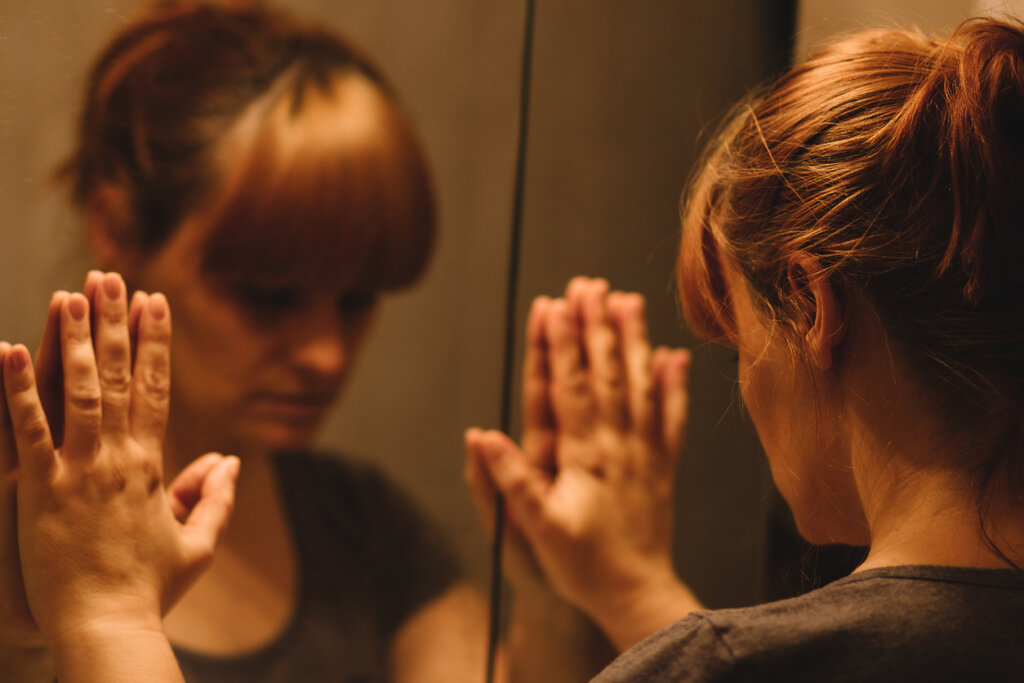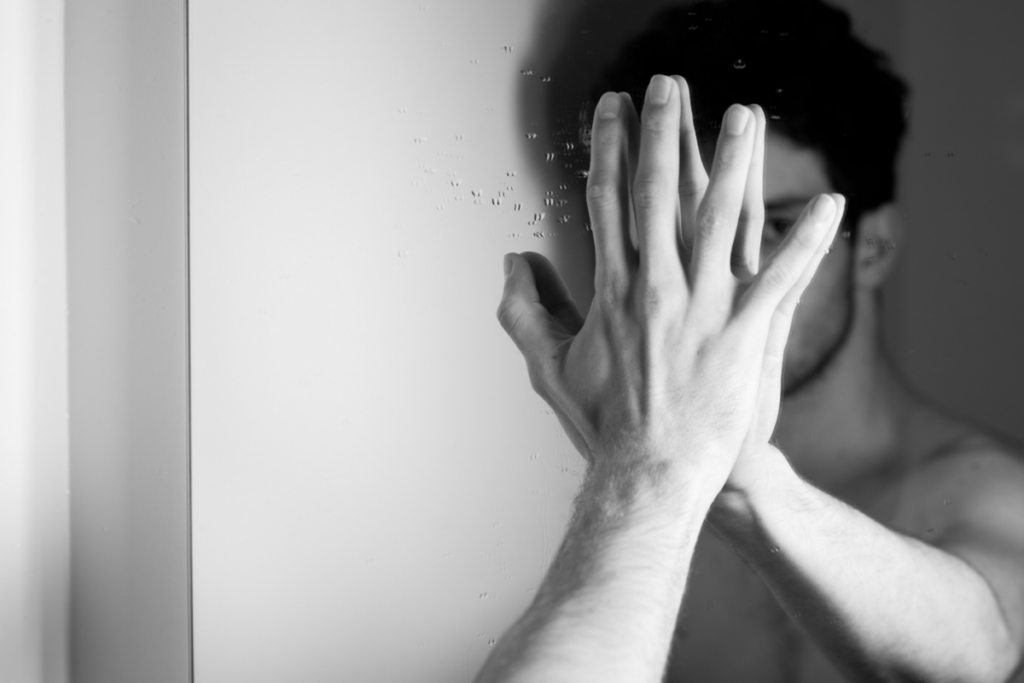Body Dysmorphic Disorder Behaviors


Written and verified by the psychologist Gorka Jiménez Pajares
Some people care a great deal about their physiques. So much so that, as a result of their obsession, they damage important aspects of their lives, such as work or family. This often occurs because body dysmorphic disorder (BDD) behaviors consume the hours of their days like a fire in the middle of a dry forest.
They make a mountain out of a molehill. Indeed, for people with body dysmorphic disorder, a flaw that, for most of us would go unnoticed is, for them, like seeing a huge black spot on a white wall. They lack the ability to look away from the black spot. In fact, for them, the defect is enormous.

Body dysmorphic disorder
According to the World Health Organization, this clinical disorder characterizes people who worry intensely about a specific defect in their appearance, despite the fact that the flaw is barely perceptible to their friends and family members. Moreover, people with BDD are usually extremely shy, a personality trait that’s characteristic of the disorder.
In addition, sufferers act in a particular way when faced with their concerns. They exhibit a series of dysmorphic behaviors that can be described as exaggerated. According to Belloch (2022), they experience concern because they feel ugly and disproportionate. They also may feel excessively feminine or masculine. In addition, as we mentioned earlier, there’s a profound impact on their academic, social, and work areas.
Features of body dysmorphic disorder (BDD) behaviors
Their concerns often focus on specific areas of their body. For instance, the face, hair, skin, and eyes. It’s also common for them to be concerned over their genital area, chest, belly, hands, and feet. They suffer a great deal when they think about how big or small the defect is, or what shape or color it is.
Pimple marks associated with acne, and acne itself, along with wrinkles, are some examples of dysmorphic concern. The degree of conviction the sufferer has about the defect could be branded as delusional.
“Individuals with BDD spend a great deal of time focused on perceived flaws and ways in which to hide these flaws.”
-Amanda Perkins-
Body dysmorphic disorder behaviors
Body dysmorphic disorder behaviors are characterized by four parameters. They’re repeated a great deal, are excessive, uncontrollable, and performed as rituals. In fact, sufferers behave in this way with the aim of diverting attention away from their flaws.
Due to the fact that BDD behaviors are time-consuming, sufferers often feel extremely tired. Here are some of the behaviors:
1. Social comparison
“Hey, do you think I have as many pimples as they do?”. Nine out of ten patients compare themselves with other people. They contrast their own flaws with the imperfections of others and evaluate the resulting differences. Those with whom they compare themselves are usually of the same sex and of a similar age.
2. Strenuous exercise
A variation of BDD is body dysmorphia. This kind of dysmorphia is typical in men who see themselves as small and not particularly muscular. For this reason, they exercise wildly in an attempt to achieve their idea of perfection: a muscular and sculpted body. However, in the search for this body shape, they end up developing BDD.
3. An obsession with mirrors
“Mirror Mirror…”. Sufferers will look in any reflective surface at their reflections. Shop windows, mirrors, car windows, rear-view mirrors, a cell phone, or even the glass in a door will do. However, consistently looking at their reflections can help maintain this obsessive disorder and hinder their recovery. This kind of behavior is carried out by nine out of ten sufferers.
“Sometimes, they look at themselves because they hope that their appearance is different from what they feared.”
-Amparo Belloch-
4. Visiting the doctor
“I need a dermatologist to do some touch-ups”. Dermatology is the medical profession most requested by sufferers of BDD. In fact, nearly seven out of ten sufferers are referred to cosmetic surgeons or dermatologists.
There have been instances where interventions have been rejected for medical and ethical reasons, and sufferers have self-harmed with the aim of receiving urgent medical intervention (Belloch, 2022).
“Performing these procedures, far from relieving symptoms, increases dissatisfaction.”
-Amparo Belloch-
5. “I don’t want it to be seen!”
The concealment of imperfection is one of the most common BDD behaviors. Sufferers use different strategies to achieve it. For instance, using high coverage makeup to prevent others from seeing the flaw. This is often the case for sufferers whose main worry is acne.
They might also use particular clothing to hide their perceived defect. For example, they’ll always wear long pants if they worry about their legs.

6. Scratching and picking
This BDD behavior occurs in one in three sufferers. However, if they scratch or pick excessively, it should be assessed as to whether they’re also suffering from an excoriation disorder. This clinical condition consists of constant scratching or picking of the skin. It leads to the formation of wounds, despite the sufferer’s attempts to stop the behavior.
7. Avoidance
Finally, if previous strategies have failed, sufferers will tend to isolate themselves. In fact, they may completely withdraw from public life because they feel that they attract the attention of others. Indeed, the anxiety they experience when they feel as if they’re being observed can become so intense that they decide to confine themselves to their homes.
As you can see, BDD behaviors can be tremendously disabling. As a matter of fact, the kind of suffering experienced means symptoms of social anxiety or depression frequently appear alongside the disorder. Likewise, substance use is also frequent. That’s because the sufferer’s ultimate goal is to alleviate their feelings of discomfort.
“BDD is a very limiting mental condition that raises concerns about body image.”
-Jose Luis Santos-
All cited sources were thoroughly reviewed by our team to ensure their quality, reliability, currency, and validity. The bibliography of this article was considered reliable and of academic or scientific accuracy.
-
Belloch, A. (2023). Manual De Psicopatologia. Vol. Ii (2.a ed.). MCGRAW HILL EDDUCATION.
-
CIE-11. (s. f.). https://icd.who.int/es
-
First, M. B. (2015). DSM-5. Manual de Diagnóstico Diferencial. Editorial Médica Panamericana.
-
Morocho, J. L. S. (2019). Evaluación, diagnóstico y tratamiento psicológico en un caso de trastorno dismórfico corporal. PsiqueMag, 8(1), 117-137.
-
Perkins, A. (2019). Trastorno dismórfico corporal. La búsqueda de la perfección. Nursing (Ed. española), 36(6), 16-20.
This text is provided for informational purposes only and does not replace consultation with a professional. If in doubt, consult your specialist.








